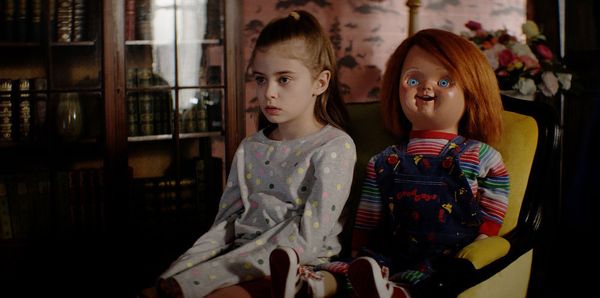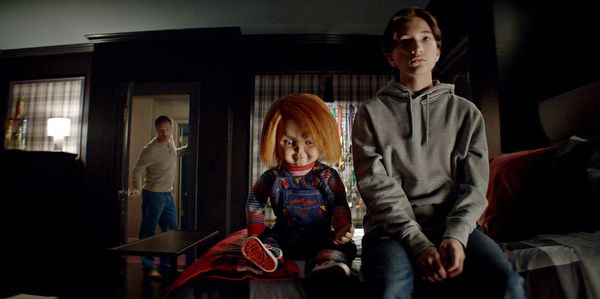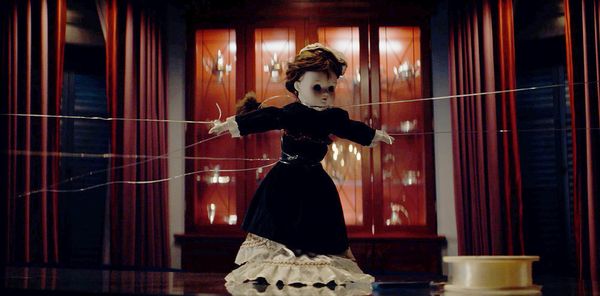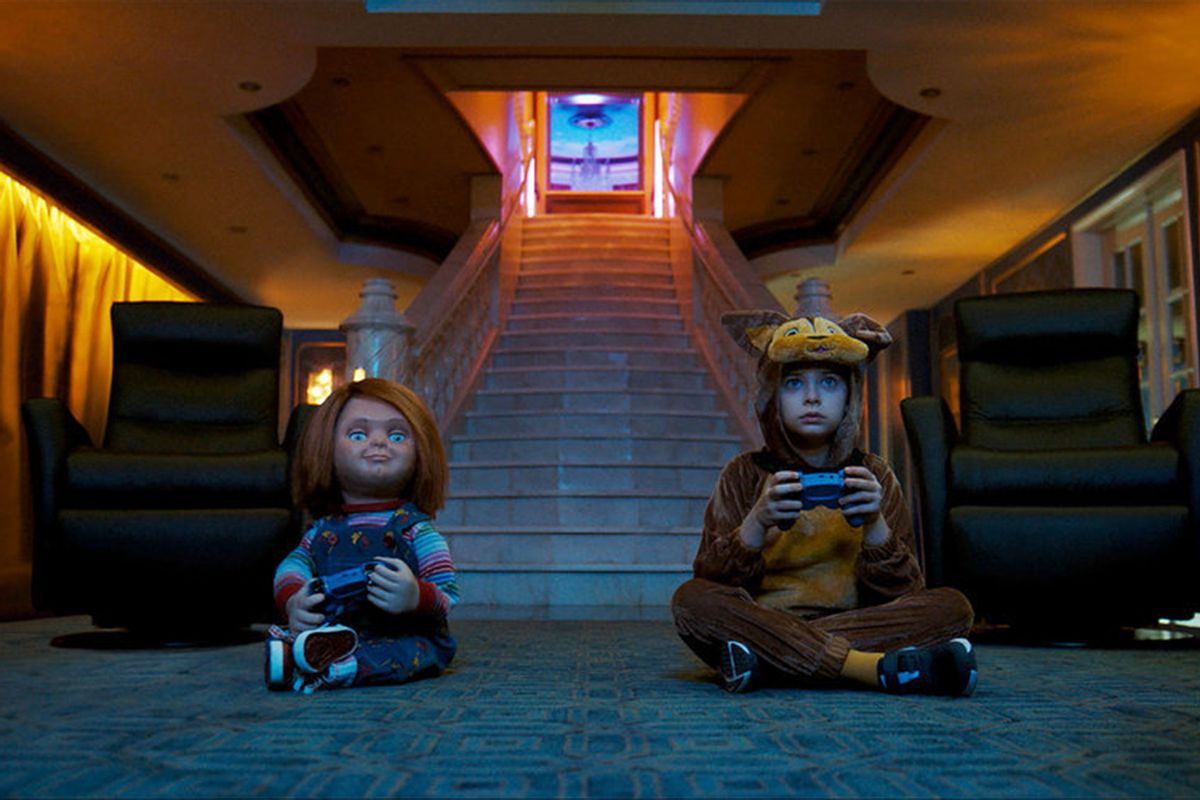One Christmas I lucked out. It was at the height of the Cabbage Patch craze and my parents had warned me that Santa Claus couldn't deliver everything, like an unprecedented, coveted doll. But Santa was no match for my uncle, who worked at Kmart and hid the last doll in the store (I believe in the gun section, where he worked), which is how I found a red-headed doll in a gingham dress waiting for me one winter morning, soon to be so beloved her cloth limbs grew soft with dirt. I never let my mother wash her for fear she would drown.
Horror films love to dwell on the doll, from "Poltergeist" to Slappy of R. L. Stine's "Goosebumps." But many dolls of horror belong to girls. Talky Tina says way too much to a little girl in "The Twilight Zone." Annabelle first terrorizes orphan girls in "Annabelle: Creation" and later is an unknowing man's gift to his pregnant wife.
The gold standard of dolls belonging to boys is Chucky. He's crass. He talks back. He's got the soul of a dead serial killer, and he crashes with his tiny hammer right into anxieties of the 1980s, especially about gender roles. He's a doll but he's also a man, and he's not going to change anything, especially himself.
Chucky first blinked out of a cardboard box in 1988's "Child's Play." The hot toy that year in fictionalized Chicago is the Good Guy doll, a large doll with a cloth body, big round plastic face, and shocking red hair. Single mom Karen (the great Catherine Hicks) can't afford one for her son. That is, until her friend happens upon a "peddler" selling a discounted one from a shopping cart in the alley. The doll for sale looks legitimate, though slightly worse for wear. She makes her son Andy's (Alex Vincent) birthday by giving it to him.
But the peddler scavanged the doll from a burned-out toy store where murderer Charles Lee Ray (the legendary Brad Dourif) died, shortly after performing a voodoo spell (stay with me!) to transfer his soul into the doll. You just can't buy your toys from back alleys anymore.
At first glance, Chucky looks familiar. That giant body (he's nearly as big as Andy and the scenes of the small boy carrying him are kind of hilarious), those blue overalls and striped shirt — was Chucky based on My Buddy?
No dads protest a boy playing with dolls in "Child's Play," in large part because there are no dads around.
Hasbro's 1985 doll was created specifically to appeal to boys, that untapped doll market, and to teach boys the importance of friends. As The New York Times reported that year, "Hasbro created My Buddy . . . because 'little boys have a soft side just like little girls,' said Stephen Schwartz, senior vice president of marketing. But before going into full production on the toy, the company interviewed parents —particularly fathers — to insure that they did not reject the idea of boys playing with dolls."
Yes, a friendship-focused doll can be controversial so better ask Dad. Yet My Buddy proved so successful, a companion doll was introduced, marketed to that old standby: girls. My sister and I both longed for but did not receive Kid Sister (my sister did have a terrifying Cabbage Patch that chewed, and more than a few kids lost hair that way). Note the pigtails of Kid Sister, the overalls changed to pastel and the theme song pitched higher.
But when I was a kid, hopeful for that clear plastic-fronted box on Christmas morning, "Child's Play" writer Don Mancini was a film student, inspired allegedly not as much by My Buddy as by our plastic overlords themselves, Cabbage Patches. "I wanted to write a dark satire about how marketing affected children," Mancini said in an interview with Mental Floss. "Cabbage Patch was really popular." Lending fuel to the My Buddy fire, however? Not only does child actor Vincent remarkably resemble one, the first title of "Child's Play" was "Blood Buddy."
 Carina Battrick as Caroline Cross and Chucky in "Chucky" (SYFY)No dads protest a boy playing with dolls in "Child's Play," in large part because there are no dads around. Single mom Karen runs the show solo as best she can, working at the department store with an unsympathetic boss and saving desperately for her son. The film taps into a lot of anxieties about the time, including crime (all the parts of the city you don't want to go to at "this time of night"), people experiencing homelessness and single motherhood.
Carina Battrick as Caroline Cross and Chucky in "Chucky" (SYFY)No dads protest a boy playing with dolls in "Child's Play," in large part because there are no dads around. Single mom Karen runs the show solo as best she can, working at the department store with an unsympathetic boss and saving desperately for her son. The film taps into a lot of anxieties about the time, including crime (all the parts of the city you don't want to go to at "this time of night"), people experiencing homelessness and single motherhood.
Never fear, however, Karen is the good kind of single mother: a widow. The movie makes that explicitly clear when Andy talks about his Daddy in heaven.
Chucky is a man's doll. His accessories are working tools.
Chucky is a man's doll. His accessories are working tools. He wears a little hard hat. Good Guys are active, jumping off a rope ladder to rescue their friends in the animated tie-in TV show that Andy watches. And once Chucky is possessed by a murderer, he wants to do guy things like watch the 9 o'clock news and insult women. He settles a score, because that's what men do.
Despite being three feet high, Chucky is hyper-masculine with a growly, deep voice. He has big incel energy, calling Karen's murdered friend "a real bitch" who "got what she deserved," and passing that toxic gospel on to Andy, his protégé. Chucky also calls Karen a "bitch" and a "slut," despite the fact, or maybe because, we've never seen any evidence that she's dated anyone. Who has time between solo parenting, department store working and stalking the wrong side of town, trying to track down that peddler?
 Devon Sawa as Lucas Wheeler, Chucky and Teo Briones as Junior Wheeler in "Chucky" (SYFY/USA Network)How to make a doll palatable to boys and their fathers? Make it misogynistic. If you watched "Child's Play" as an actual child, as I did, you may have forgotten it's near-rape scene. Apologies for reminding you. You may have also tuned out the murals, seemingly self-painted, on the walls of Charles Lee Ray's apartment: a lot of naked people, mostly men, with exaggerated genitals, the film dabbling in that distasteful trope: the queer monster. Chucky says he's "got a date with a 6-year-old boy" when he learns his soul must be transferred into Andy.
Devon Sawa as Lucas Wheeler, Chucky and Teo Briones as Junior Wheeler in "Chucky" (SYFY/USA Network)How to make a doll palatable to boys and their fathers? Make it misogynistic. If you watched "Child's Play" as an actual child, as I did, you may have forgotten it's near-rape scene. Apologies for reminding you. You may have also tuned out the murals, seemingly self-painted, on the walls of Charles Lee Ray's apartment: a lot of naked people, mostly men, with exaggerated genitals, the film dabbling in that distasteful trope: the queer monster. Chucky says he's "got a date with a 6-year-old boy" when he learns his soul must be transferred into Andy.
The sequel, which some argue is the better film, shows how much we believe women. Not much. In "Child's Play 2," Karen has been committed to a mental hospital and Andy is in foster care. A series of sequels, some direct, some remakes, continue to comment on gender roles and expectations, from Andy forced to enroll in military school in "Child's Play 3" to Jennifer Tilly entering the story as a wedding dress-wearing female doll in "Bride of Chucky" (whose tagline is "Chuck gets lucky").
 The Creepy Doll from "Chucky" (SYFY/USA Network)In "Chucky," Syfy's version of the story in series form, now entering its second season, the boy, Zackary Arthur as Jake, is older, a teenager. He picks up Chucky at a garage sale not to play with but to turn into art. "Chucky" provides a welcome update to the killer doll story: Jake is openly queer (and has his first kiss with a boy). "Child's Play" creator Mancini, who also created the Syfy show, is gay and told GayTimes the series "gave me an opportunity to really be more personal, and even autobiographical than I've ever been before."
The Creepy Doll from "Chucky" (SYFY/USA Network)In "Chucky," Syfy's version of the story in series form, now entering its second season, the boy, Zackary Arthur as Jake, is older, a teenager. He picks up Chucky at a garage sale not to play with but to turn into art. "Chucky" provides a welcome update to the killer doll story: Jake is openly queer (and has his first kiss with a boy). "Child's Play" creator Mancini, who also created the Syfy show, is gay and told GayTimes the series "gave me an opportunity to really be more personal, and even autobiographical than I've ever been before."
The new season tackles religion, like "Fleabag" (sort of) in its sophomore year, and takes Jake and others to the Catholic School of the Incarnate Lord. Save the world from Chucky and his ilk and hold on to yourself in the face of adults trying to deny you personhood? OK, friend to the end!
Want a daily wrap-up of all the news and commentary Salon has to offer? Subscribe to our morning newsletter, Crash Course.
Kids grow and change but some things sadly stay the same, like dads stuck in the past. In "Chucky," Jake's dad, who wishes he would just ask a girl out or play sports, scoffs: "Another freaking doll?" Nope. Just the same old murdering one, this time in a story that comments on and rejects the toxic past in favor of a much brighter future.
"Chucky" airs Wednesdays at 9 p.m. on Syfy. Watch the trailer via YouTube below



Shares